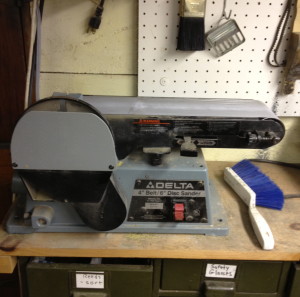
This is my Trusty Delta 4″ x 36″ belt sander that has flattened hundreds of harmonica combs and lower reed plates ove the years. A real time saver, once you get the hang of using it. You need several different belts with different grits, including fine grit. I removed a sanding disk that was attached to the unit. (the grey plate in front on the left covers the area where the disk sander was). Also took off the piece that goes over the sanding belt to keep things from getting snagged by the belt and sent flying.
If you use a belt sander set up like this one, you can expect to send a bunch of reed plates and combs flying across the room until you get your technique together. I also removed flesh from my fingertips more than once. You have been warned!
One last tip – it is worth it to buy expensive high quality belts for your harmonica work. Keep a couple of cheaper ones on hand for household projects and other non-harmonica work. Do that and your best belts will last for years.

5 Comments
Michelle LeFree
May 26, 2013 - 5:32 pmRichard, I have a Delta disc/belt sander, too. It’s only a 2″ wide belt, though. It’s amazing how useful and versatile this tool is. Dig it!
rharp
May 28, 2013 - 1:13 amThe belt sander I use has a plate under the belt. This gives you a flat surface to push against. If your sander has a similar arrangement, then it should work fine. I have seen belt sanders with narrow belts that did not have the belt supported by a flat surface big enough to support a harmonica comb. Without the plate under the belt you could not flatten the comb….
Doug Baz
May 27, 2013 - 11:15 amHi Richard:
Like your new website! Do I understand the above to say that you only sand/ flatten the Lower reed plates? Why?
Thanks
Doug
rharp
May 28, 2013 - 12:50 amHi Doug,
You can only sand the side of the reed plates that has no reeds. On the lower reed plate, the side with no reeds is the side that contacts the comb. The upper (or blow) reed plate has the reeds on the inside, so you can’t snd the side of the reed plate that contacts the comb. There is no point in sanding the top of the upper reed plate.
This will all make sense when you take a look at what I am talking about.